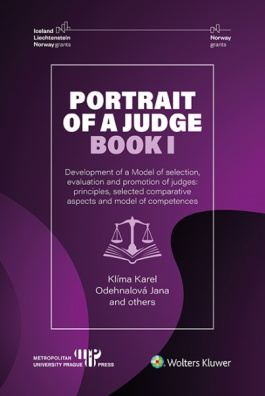Zaradené v kategóriách: PRÁVNICKÁ LITERATURA, Občanské právo
Portrait of a Judge. Book I; Development of a Model of selection, evaluation and promotion of judges
Karel Klíma, Jana Odehnalová
ISBN
978-80-7676-726-3
EAN
9788076767263
Publikace shrnuje nejvýznamnější výstupy z mezinárodního projektu organizovaného Litevskou univerzitou a realizovaného v rámci grantu ,,Norských fondů“, který je sice zjednodušeně označen jako ,,Portrét soudce“, ale s podtitulem „vícerozměrný model kompetencí, který má být měřen během postupu výběru, hodnocení a povyšování soudců". Je tak zřejmé, že je zaměřen na osobu a funkci ,,soudce“, přičemž zde na základě evropské srovnávací studie dochází autoři ke specifikování vhodných kompetencí, které mají být zjišťovány a měřeny v průběhu výběru soudců na první pozici, jejich hodnocení a povyšování, a to jak na vyšší soudy, tak při ustavování do manažerských postů soudů. Ve formě barevné grafické tabulky v druhé části knihy pak autoři přehledně uvádí soubor kompetencí, které se používají v procesu jmenování, hodnocení a povyšování soudců, jakož i kritéria a metody, jak měřit tyto kompetence. Tento model byl konstruován jako flexibilní, přičemž barvy semaforu označují, jaké požadavky, kritéria a metody jsou považovány za ,,dobré mít“ (zelené), až k těm, které, pokud jde o naše odborníky, by součástí postupů výběru, hodnocení a povyšování soudců být neměly (červené).
Realizace projektu ,,Portrét soudce“ také v širším kontextu vychází z četných záruk a aspektů nezávislosti soudnictví, zejména ve vztahu k výkonné moci, ale zohledňuje také postupný vliv judikatury na rozhodování soudů členských států Rady Evropy. Nezávislost soudnictví je jednou ze základních evropských hodnot, které vládnou právním státům a jejich ústavním systémům. Proto je tomuto problému věnována neustálá pozornost ve vědecké a pedagogické činnosti vysokých škol a výzkumných ústavů a samozřejmě i špičkových soudních institucí. I z tohoto důvodu je velmi cenná účast zástupců Nejvyššího soudu Litevské republiky, Vrchního soudu v Praze a Nejvyššího soudu Albánie, jakož i zástupců Nejvyšších rad soudnictví Litvy a Albánie.
--------------------------------------
The publication summarizes the most important outputs from an international project organized by the University of Lithuania and implemented within the framework of the ,,Norway Grants” grant, which is simply described as ,,Portrait of a Judge”, but with the subtitle ,,A multidimensional model of competencies to be measured during the process of selection, evaluation and promotion of judges”. It is thus clear that it is focused on the person and function of the ,,judge”, and here, on the basis of a European comparative study, the authors specify appropriate competencies to be identified and measured during the selection, evaluation and promotion of judges in the first position, both to higher courts and when appointing to managerial positions of courts. In the form of a coloured graphical table in the second part of the book, the authors clearly present the set of competences that are used in the process of appointing, evaluating and promoting judges, as well as the criteria and methods for measuring these competences. This model has been designed to be flexible, with traffic light colours indicating which requirements, criteria and methods are considered 'good to have' (green), up to those which, as far as our experts are concerned, should not be part of the process of selecting, evaluating and promoting judges (red).
The implementation of the ,,Portrait of a Judge” project also builds on numerous guarantees and aspects of judicial independence, in particular in relation to the executive, in a broader context, but also takes into account the gradual influence of case law on the decision-making of the courts of the member states of the Council of Europe. The independence of the judiciary is one of the fundamental European values that govern the rule of law and their constitutional systems. Therefore, constant attention is paid to this issue in the scientific and pedagogical activities of universities and research institutes and, of course, top judicial institutions. For this reason, the participation of representatives of the Supreme Court of the Republic of Lithuania, the High Court in Prague and the Supreme Court of Albania, as well as representatives of the Supreme Judicial Councils of Lithuania and Albania, is very valuable.
Ostatní s tímto titulem kupují:
-
Položka byla přidána do košíku.
















